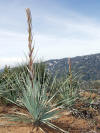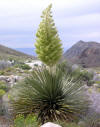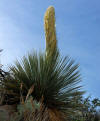|
Nolina cismontana |
Nolina microcarpa |
|
Nolina parryi
|
Nolina parryi |
|
Trees and Shrubs of Kern County (Jan 2013) Nolina parryi S. Watson 1879. Parry's nolina. (Ruscaceae). Habit much like Yucca schidigera with leaves more like Hesperoyucca whipplei; leaves densely tufted and radiating from a short erect trunk, very long and numerous (65–200), >50× longer than wide, strap-like but gradually wider towards a short, abruptly dilated to a white fleshy base, otherwise greenish, sawtooth (serrate) along margins; flowering Apr-Jun, main flower stems one to several or more arising centrally from the apex of the trunk, erect, 1–4 m long, with floriferous branches to the base, the whole inflorescence pyramidal in outline, pedicels jointed near base; tepals 6-parted, white, < 6 mm, persistent; ovary superior, 3-chambered, each with 2 ovules; fruit a triangular lobed replicidal capseratium, membranous, irregularly cracking between the carpellary ribs, which may also separate. Generally along the western edge of the deserts, Kern Plateau, San Bernardino Mts., and Peninsular Ranges, also in Mojave Desert mountains, 3,000–6,500 ft. Nolina scrub recognized by MCV2 when >3% absolute cover and evenly distributed in the shrub canopy. Type from near Whitewater, desert slopes of the San Bernardino Mts. Kern Co.: Known from the southern Sierra Nevada at Fay Creek, Rancheria Weldon, Short Canyon, Walker Pass, and Pacific Crest Trail between Morris Peak and Mount Jenkins, 853–2.053 m (CCH). Pharmacological References Mimaki Y., Y. Takaashi, M. Kuroda, Y. Sashida and T. Nikaido. 1996. Steroidal saponins from Nolina recurvata stems and their inhibitory activity on cyclic AMP phosphodiesterase. Phytochemistry 42(6): 1609–1615. “Seven steroidal saponins were isolated from the stems of Nolina recurvata, five of which appeared to be new compounds and were assigned as spirosta-5,25(27)-diene-1 beta,3 beta-diol (neoruscogenin) 1-O--O-alpha-L-rhamnopyranosyl-(1--> 2)-O-[beta-D-xylopyranosyl-(1-->3)]-alpha-L-arabinopyranoside-, (25S)-spirost-5-ene-1 beta,3 beta-diol [(25S)-ruscogenin] 1-O-{O-alpha-L-rhamnopyranosyl-(1-->2)-O-[beta-D-xylopyranosyl-(1--> 3)]-alpha-L-arabinopyranoside}, neoruscogenin 1-O-{O-alpha-L-rhamnopyranosyl-(1-->2)-O-[beta-D-xylopyranosyl-(1--> 3)]-beta-D-fucopyranoside}, 26-O-beta-D-glucopyranosyl-22-O-methylfurosta-5,25(27)-diene-1 beta,3 beta,22 xi,26-tetrol 1-O--O-alpha-L-rhamnopyranosyl-(1--> 2)-O-[beta-D-xylopyranosyl-(1-->3)]-alpha-L-arabinopyranoside- and 26-O-beta-D-glucopyranosylfurosta-5,20(22),25(27)-triene-1 beta,3 beta,26-triol 1-O-{O-alpha-L-rhamnopyranosyl-(1--> 2)-alpha-L-arabinopyranoside}. The isolated saponins were evaluated for their inhibitory activity on cyclic AMP phosphodiesterase to identify new compounds with medicinal potential.” |
|







